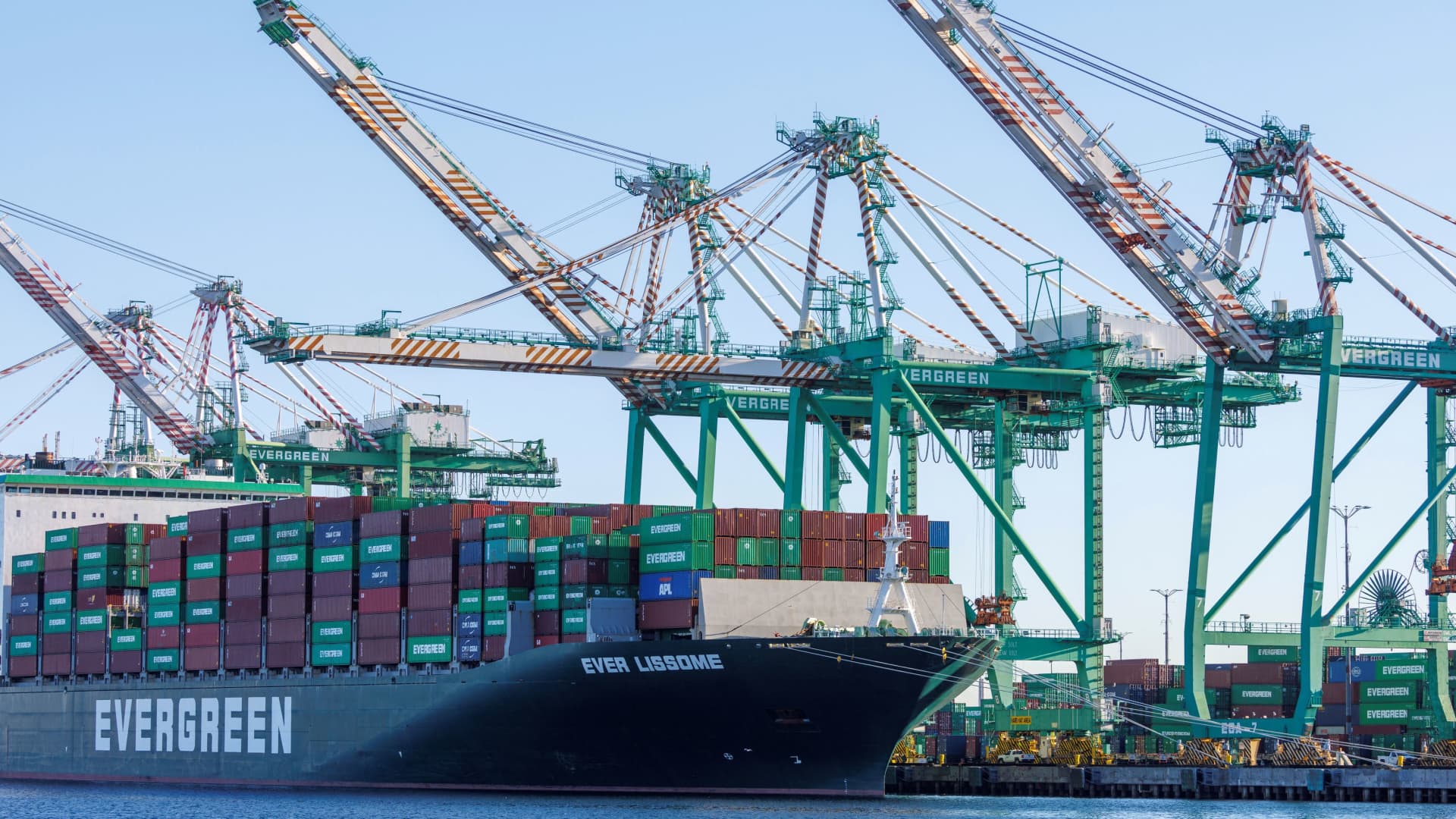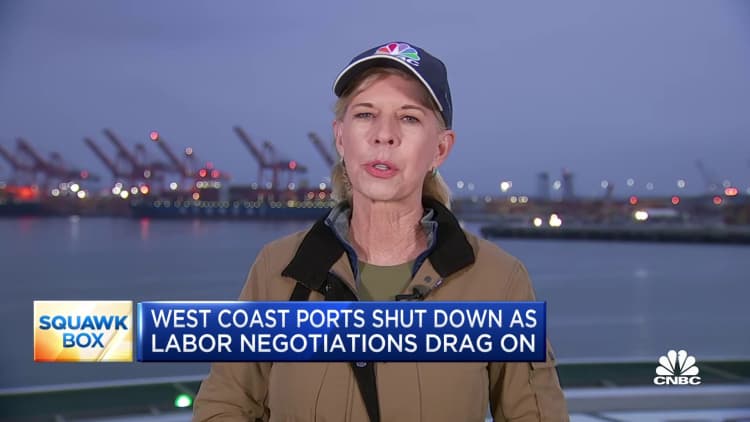Seattle, WA
West Coast port labor issues persist from Los Angeles to Seattle, with supply chain frustration mounting

A container ship is shown at the Port of Los Angeles in Los Angeles, California, November 22, 2021.
Mike Blake | Reuters
Just hours after the reopening of the West Coast ports on Monday after multiple closures that began at the Port of Oakland last Friday when some union workers refused to report for assignments, issues remain at select terminals within ports from Los Angeles to Seattle, with labor slowdowns and shift closures.
ITS Logistics tells CNBC its truckers were turned away by the terminal operator Fenix Marine Services, which is owned by ocean carrier CMA-CGM, at the Port of Los Angeles during the first shift Monday. They were picking containers from a variety of ocean carriers. Containers processed through the terminal include those owned by Maersk, OOCL, COSCO Shipping, Sealand (a Maersk company), and Evergreen.
“Navigating the ports on the entire West Coast over the last four days has been extremely frustrating for us and our clients,” said Paul Brashier, vice president of drayage and intermodal at ITS Logistics. “If it were not for updates from our drivers and our visibility software applications, we would not have even known about terminal closures Friday, throughout the weekend, and into today. Terminal announcements were severely lagging at best if they were issued at all, and announcements from the ILWU were misleading,” he said in a reference to the International Longshore and Warehouse Union, which has been engaged in a protracted battle over a new contract with port management.
Terminal alerts to trucking companies obtained by CNBC starting at 9:39am PT show some import appointments being canceled at Fenix Marine. Later in the morning, the dayside shift was cancelled, though Brashier learned of the cancellations earlier from his truckers who were turned away from picking up their containers.
Another Los Angeles Port terminal, Pacific Container Terminal (owned by SSA) announced Monday morning to truckers they would be closing the dayside shift on Tuesday. The terminal was already closed Monday for a scheduled closure which was announced approximately a week ago.
The Port of Los Angeles, the nation’s busiest port, processes $440 billion in cargo value per year. That market share has declined with more trade moving to the East Coast over the past year, at least partially due to labor issues on the West Coast that had supply chain managers worried about reliability of service. Recently, as the labor negotiations on the West Coast were said to have made progress, more trade started coming back. Port officials tell CNBC there are 52 vessels in route from China to the Port of Los Angeles, a number of vessels they have not seen since the diversion of trade to the East Coast and pullback in shipping orders. Oakland has also seen a recent increase in volume.
The Port of Long Beach is open and operating today after issues over the weekend, although two of its six container terminals were closed for the day shift. Operators of those terminals made the decision to close based on operational needs and were expected to reopen for the evening shift, the port said in a statement. TTI which closed the dayside shift Monday will open their second shift Monday afternoon but the appointments are light.
Port officials have stressed since Friday that they are operational, with select closures, and the ILWU said talks between the union and port management have not broken down. When issues began last Friday in Oakland, the union described actions by rank-and-file members to not show up for shift assignments as “voicing their displeasure.” The ports’ negotiation body, the Pacific Maritime Association, described it as coordinated union action.
On Monday, port sources said workers reported to assignments, but that slower than required performance led some workers to be relieved of duties. SSA Terminal in Seattle was reported to have released laborers working a vessel for not maintaining standard operating levels.
The ILWU and PMA are not commenting, citing a media blackout.

These operational disruptions have a cost to the supply chain and risk more damage to key sectors which ultimately flow through to consumer prices.
Sending drivers to ports on the off-chance that logistics companies may be able to get containers out either incurs dry-runs — when containers cannot be pulled — or congestion limits the amount of turns a driver can do in a day, Brashier explained. The congestion creates a situation where two or three extra truck drivers are needed to be hired to remove the containers stuck in congestion. “Both are charges that we do our best to avoid to prevent inflationary pressure throughout the supply chain,” he said. ITS Logistics is continuing to staff weekends and around the clock despite the new headwinds, he added.
The National Retail Federation issued a statement on Monday reiterating its position that the Biden Administration should intervene in the labor talks, worried delays could fuel inflation and impact the delivery of products during peak shipping season which runs from July to October, covering back-to-school and holiday seasons.
“It is imperative that the parties return to the negotiating table. We urge the administration to mediate to ensure the parties quickly finalize a new contract without additional disruptions,” said David French, senior vice president of government relations at NRF in a statement.
Project44, a CNBC Supply Chain Heat Map provider, tells CNBC the ongoing labor disruptions at ports along the West Coast will cause significant repercussions on global supply chains if not solved promptly.
MarineTraffic, a CNBC Supply Chain Heat Map data provider analyzed he vessels traveling from China to the ports of Los Angeles and Long Beach and identified some vessels loitering in the water awaiting to dock at the Port of Los Angeles. The MSC Jeongmin was seen leaving the Port of Oakland, traveling down the coast of California, and then stopping in the open waters off of Santa Barbara where it proceeded to circle in place.
With a 40% share of imports flowing into the U.S. passing through these ports, persistence of terminal shutdowns will trigger reduced inventories and a continued shift away from West Coast ports to ports like New York, said Jenna Slagle, senior data analyst with with Project44.
“These additional disruptions will force retailers and other important shipping partners to continue to shift cargo away from the West Coast ports until a new labor contract is established,” French said.
The current labor strife already has impacted the delivery of containers at ports where issues have arisen.
Container wait times for the ports of Long Beach and Los Angeles are both experiencing a slight increase in dwell times.
North of the ports of LA and Long Beach, the Port of Oakland has seen the most impact as it relates to container wait times.
On Monday, the Port of Oakland’s marine terminals were operational, said Robert Bernardo, spokesman for the port.

Seattle, WA
$3M bail set for man accused of murdering chef at Seattle light rail

The man King County prosecutors said killed Chef Cory Bellett at the Capitol Hill Link light rail station over the weekend had his first court appearance Tuesday afternoon.
The 26-year-old opted not to attend the hearing. A defense attorney was there instead.
Prosecutors were seeking probable cause for the charges of murder in the second degree with a deadly weapon enhancement and witness tampering.
According to court documents, Bellett brushed against the suspect as he was descending an escalator. Then on the platform, there was an argument, a fight, and then the stabbing. The King County Medical Examiner reports Bellett was stabbed or cut three times with a box cutter, including once in the neck and once in the torso.
Past coverage: Man arrested following deadly light rail stabbing of beloved Seattle chef
Prosecutors said the $3 million bail is necessary.
“That is based on both a danger to the community that the defendant would pose if he were released, as well as the significant risk of flight should he be released,” Sr. King County Dep. Prosecutor Jason Brookhyser said.
But the defense had a different view. They said that the use of force by the suspect may have been warranted.
“A reasonable inference can be made that getting shoved, unprovoked, next to the light rail tracks could give rise to reasonable belief of imminent harm or death,” defense attorney Brooks DePeyster said.
Bellett worked at Harry’s Fine Foods and was a beloved chef in the Seattle restaurant community.
“We’re all connected, somehow,” Shea Bigger, a local bar server told KIRO 7. “We all have mutual friends. So, it does, you know, you feel it.”
Back at the light rail station, passengers are calling for more security.
“More security presence on the trains, on the platforms, where all the heavy traffic is,” light rail passenger George Alvarez told KIRO Newsradio.
A Sound Transit spokesperson told KIRO Newsradio that attacks like this are extremely rare and the trains are very safe.
However, Bellett’s death is the second time this year that someone has been killed at a Link light rail station.
The name of the suspect hasn’t been released because he hasn’t been charged yet. He’s due back in court Thursday afternoon.
You can read more of James Lynch’s stories here. Follow James on X, formerly known as Twitter, or email him here.
Seattle, WA
Seattle Mariners’ Top Prospect Uncorks First Professional Home Runs

Eighteen-year-old Felnin Celesten, who is already the No. 5 prospect in the Seattle Mariners organization, hit his first professional home runs on Monday night while playing for the Mariners team at the Arizona Complex League.
Per the Prospect One Podcast group:
Felnin Celesten @Mariners with an absolute BOMB for his first professional home run! look at him adjust and take this high fastball up and out to dead center about 430. #ProspectOne
Felnin Celestin @Mariners with an absolute BOMB for his first professional home run! look at him adjust and take this high fastball up and out to dead center about 430. #ProspectOne pic.twitter.com/B45LSTsFAh
— The Welsh (@IsItTheWelsh) May 14, 2024
A shortstop, Celesten is hitting .423 in seven games this year at the complex level. He’s got a .516 on-base percentage and six extra-base hits. He actually homered twice on Monday night and could be a quick riser through the Mariners system.
Per a portion of his MLB.com prospect profile:
Signed for $4.7 million as the No. 2 prospect in MLB Pipeline’s international class for 2023, Celesten immediately ascended near the top of the organization’s rankings with perhaps as much upside as any position player in the system. The switch-hitting shortstop has even been touted with the highest ceiling of any international shortstop in a decade, including Marco Luciano and Robert Puason. A huge factor in that hype was related to his performances in Colombia and the U.S., along with grander tournaments in the Dominican Republic against older competition.
While the Mariners have long been built on pitching, right now the top five prospects (Cole Young, Harry Ford, Colt Emerson, Laz Montes and Celesten) are all position players, which should give M’s fans hope, considering the organization has longed for consistent offense.
Continue to follow our Fastball on FanNation coverage on social media by liking us on Facebook and by following us on Twitter @FastballFN.
Seattle, WA
A New York State of Mind

I love the Northwest, but there’s no place like New York City. Recently, I was there for some meetings. As I walked from one neighborhood to another, taking in the intellectual stimulation and people-watching, I understood the importance of adopting a New York State of Mind, at least occasionally. Let me explain.
To begin, all the senses are aroused. Most storefronts confront you with intriguing possibilities. Along my walk to lunch, I passed a children’s bookstore and got lost browsing in it for a while. I noticed the clothing stores — none of them franchises. I didn’t dare go in any, but admired the pricey outfi ts. Every half hour or so, I would pass a small museum. My favorite was the photography museum, where I couldn’t resist buying a poster.
Second, there’s the architecture: a mix of buildings, each one interesting to scan from bottom to top. Some have helicopter pads. The 18th-century buildings have exquisite and ornate detail. Skyscrapers boldly change shape halfway up. I imagined the penthouses at the top, a place only true titans of business can afford.
Third, infectious enthusiasm is evident on every street. High volumes of people walk together energetically, sharing snippets of conversation. Their confidence shows in the way they cross the street. Not one person waits for a “walk” signal. This is a town of extreme chutzpah, where the walkers own the streets.
Fourth, the people themselves are fabulous entertainment. Every race, ethnicity, age, class, and fashion — not to mention the full spectrum of mental health — is represented. My favorite was the stereotypical East Side matron, pushing a dual carriage with trickedout 3-year-old twins. Both had designer haircuts and elegantly tailored suits, ties, and Brooks Brothers shirts. You don’t see this in Seattle.
Fifth, the intensity of places to eat: bagel shops, fruit and vegetable markets, and streets filled with sidewalk tables. Italian, Greek, Japanese, Armenian, French — restaurants not too much bigger than their doorways, each with their own boosters in the neighborhood. The only thing that stopped me from multiple drop-ins was the fact I was heading to a business lunch.
So why am I sharing this with you? Because you should go. As one of the few great cities in the world, New York is reasonably accessible to us. The experience wakes us up. It broadens our perspective and creates ideas. Yes, there are a lot of problems like potholes, poverty, and politics. But New York will make you feel as though you’ve plugged into a socket and new energy is coursing through you. Your mind will go into hyper-speed. You’ll feel expansive, creative, and grateful for the new experiences. All this, just by walking across town.
Q: I love my husband. He is a good man, and we have an OK sex life. So that’s the problem — it’s just an OK sex life. My husband will not do anything fancy, and by that, I mean oral sex. He just doesn’t like it and won’t do it. But I miss it. I was married before him and that was a great part of our sex life, and it made it easier for me to have an orgasm. How do I get him to get over his distaste for something I like so much?
A: My first question to you: Did he ever do oral sex? With anyone else or early in the relationship? If he did, there might be a hygiene issue. Even married people sometimes don’t give each other accurate information on why they do or don’t like a specifi c sexual act. Perhaps you have a bacterial infection or do not get nicely washed up before sex — it could make a difference. So that’s at least worth looking into, even if it could be an awkward discussion.
If that’s not the issue, and if he has never liked oral sex or practiced it with you (or practiced it infrequently), you have then acquiesced to the lack of oral sex in the relationship. Making it a big deal now might genuinely upset him. Thus, you have two choices: Live without something you really miss (because you have already done so for quite awhile) or get the two of you to sexual therapy, specifi cally one that has getaway weeks or weekends where you can get support to reinvent your sex life.
These getaway therapies really can change habits. It’s hard to change them otherwise. But there are some great therapists who do them, and if you write to the American Association of Sex Educators, Counselors and Therapists, they can tell you who is licensed in your area and what avenues of research could help you find the therapeutic situation. Of course, this requires that you and your husband would be enthusiastic about this kind of experience, and you could afford it, so there are a lot of “ifs.” But if oral sex is very important to you, then it’s at least worth considering some therapeutic intervention, which would require meaningful discussion and some guided experimentation.
Q: I need some help. My husband is very impulsive, and I don’t know what to do about it. He thinks I am a grouch and overly cautious, but he has gotten us into financial trouble. Examples: He bought a huge TV without us discussing it. We already had a big TV. He bought round-trip nonrefundable tickets for a trip that I cannot go on because of a business function. He bought our children an iguana that neither of them wanted. What to do?
A: Impulsiveness can be a very hard habit to break. Some literature suggests it can have a genetic component. That said, it can be very dangerous both financially and physically, so while I am going to give you some advice, I think you might want to think about some therapy — perhaps starting as couples therapy (because he thinks it’s your problem and you need a third party to convince him that he has an issue that is not just a result of a difference in your temperaments).
Basically, most very impulsive people are nervous and have recurring anxiety. Buying something expensive or jumping at some chance that might not really be the right opportunity (either at that time, or ever) is soothing to them. It gives a sense of power and, oddly enough, control. Once it rewards a pleasure center in the brain (the same immediate way chocolate or a sexual climax can do), the impulsive moment tugs at the person because they yearn for repeating that “high.”
There is major reluctance to change because the thrill is so rewarding. Even if there is buyer’s remorse or some other negative consequence (like your reactions, for example), the impulsive person doesn’t want to forgo that excitement and momentary rewards.
You can talk about it with him and see if there is some middle ground. For example, when he gets excited about buying something or going somewhere, agree to meet and talk about it, promise to not always be a “downer,” and see if there’s a way to accommodate his desires. He might be willing to do that, and that could help a lot. Or agree that impulse purchases have an expenditure lid, and that you both agree to stick to that limit.
Start there, but if there is no way he can modify his impulsive pattern, then some couples counseling, and ultimately, some individual counseling for him, really needs to happen if anything is to change.
-

 Politics1 week ago
Politics1 week agoHouse Dems seeking re-election seemingly reverse course, call on Biden to 'bring order to the southern border'
-

 Politics1 week ago
Politics1 week agoFetterman says anti-Israel campus protests ‘working against peace' in Middle East, not putting hostages first
-

 World1 week ago
World1 week agoGerman socialist candidate attacked before EU elections
-

 News1 week ago
News1 week agoUS man diagnosed with brain damage after allegedly being pushed into lake
-

 World1 week ago
World1 week agoGaza ceasefire talks at crucial stage as Hamas delegation leaves Cairo
-

 Politics1 week ago
Politics1 week agoRepublicans believe college campus chaos works in their favor
-

 World1 week ago
World1 week agoStand-in Jose Raul Mulino wins Panama presidential race
-

 World1 week ago
World1 week agoTech compliance reports, Newsletter






/cdn.vox-cdn.com/uploads/chorus_asset/file/24016888/STK093_Google_01.jpg)











